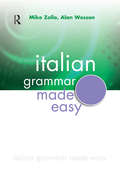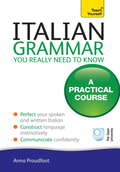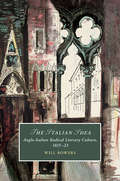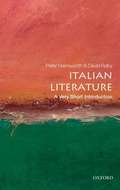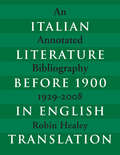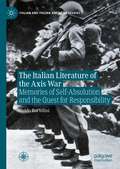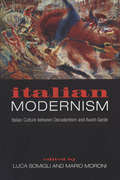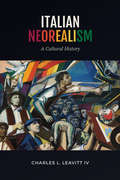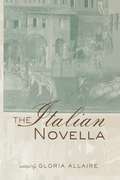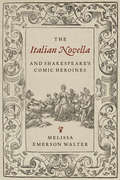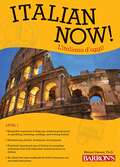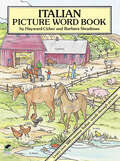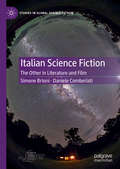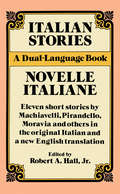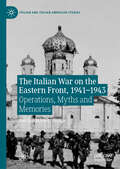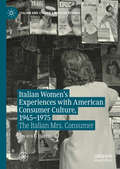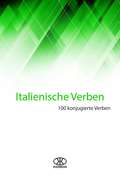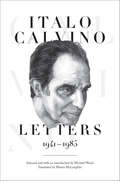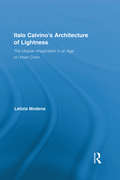- Table View
- List View
Italian Grammar Made Easy (Grammar Made Easy)
by Mike Zollo Alan WessonThe Grammar Made Easy series is ideal for complete beginners as well as for those non-linguists who have some knowledge of the language but need to know the basics of grammar to progress beyond phrasebook level.The books consist of seven units that present basic grammar topics in an accessible and non-patronising manner. The interactive CD-ROM provides extensive interactive grammar practice, it contains around 220 activities (those included in the book plus extra ones) covering all the language in Italian Grammar Made Easy. Learners work at their own pace and move through the different sections with ease.Numerous grammar tips are at hand if needed. All the correct answers will be recorded so that learners can practise their listening and pronunciation skills.The CD-ROM can be used with the book or on its own as a revision tool.
Italian Grammar You Really Need To Know: Teach Yourself
by Anna ProudfootComprehensive and clear explanations of key grammar patterns and structures are reinforced and contextualized through authentic materials. You will not only learn how to construct grammar correctly, but when and where to use it so you sound natural and appropriate. "Italian Grammar You Really Need to Know will help you gain the intuition you need to become a confident communicator in your new language.
Italian Grammar You Really Need To Know: Teach Yourself
by Anna ProudfootComprehensive and clear explanations of key grammar patterns and structures are reinforced and contextualized through authentic materials. You will not only learn how to construct grammar correctly, but when and where to use it so you sound natural and appropriate. "Italian Grammar You Really Need to Know will help you gain the intuition you need to become a confident communicator in your new language.
The Italian Idea: Anglo-Italian Radical Literary Culture, 1815–1823 (Cambridge Studies in Romanticism #128)
by Will BowersFrom 1815 to 1823 the Italian influence on English literature was at its zenith. While English tourists flocked to Italy, a pervasive Italianism coloured many facets of London life, including poetry, periodicals, translation, and even the Queen's trial of 1820. In this engaging study Will Bowers considers this radical interaction by pursuing two interrelated analyses. The first examines the Italian literary and political ideas absorbed by Romantic poets, particularly Lord Byron, Leigh Hunt, and Percy Bysshe Shelley. The second uncovers the ambassadorial role played in London by Italians, such as Serafino Buonaiuti and Ugo Foscolo, who promoted a revolutionary idea of their homeland and its literature, particularly Dante's Commedia. This dual-perspective study reveals the cosmopolitan challenge to Regency mores embodied in both the work of Italian literary exiles in London and the English poetic engagement with Italy.
The Italian Language Today
by Anna Laura Lepschy Guilio Lepschy'a truly authoritative short Italian grammar ... possibly the best concise account now available in any language' - The Times Literary Supplement 'a stimulating and scholarly introduction to Italian for the serious student. It contains a great deal of original material and the authors' unequivocal attitudes to the linguistic reality of modern Italy...make it important that it should be read and discussed by Italianists everywhere' - The Times Higher Education Supplement 'a major new contribution to the literature in English...it will be an essential part of the linguistic formation of every Italianist' - The Year's Work in Modern Language Studies Recently revised to bring it completed up-to-date, this book remains a unique source on the Italian language as it is actually spoken and written in Italy. The combination of historical perspective and contemporary grammar make it particularly useful for Italian linguistics.
Italian Literature (A Very Short Introduction)
by Peter Hainsworth ;David RobeyThey explore some of the distinctive traditions of the literature, such as its liking for theorizing its own position, its concern with politics, and its secular orientation in spite of the Catholic beliefs and practices of the Italian people. Concluding by looking at the ways in which Italian literature has changed over the last thirty years, they examine the influence of women's writing in Italian, and acknowledge the belated recognition of its importance.
Italian Literature before 1900 in English Translation
by Robin HealeyItalian Literature before 1900 in English Translation provides the most complete record possible of texts from the early periods that have been translated into English, and published between 1929 and 2008. It lists works from all genres and subjects, and includes translations wherever they have appeared across the globe. In this annotated bibliography, Robin Healey covers over 5,200 distinct editions of pre-1900 Italian writings. Most entries are accompanied by useful notes providing information on authors, works, translators, and how the translations were received.Among the works by over 1,500 authors represented in this volume are hundreds of editions by Italy's most translated authors - Dante Alighieri, Machiavelli, and Boccaccio - and other hundreds which represent the author's only English translation. A significant number of entries describe works originally published in Latin. Together with Healey's Twentieth-Century Italian Literature in English Translation, this volume makes comprehensive information on translations accessible for schools, libraries, and those interested in comparative literature.
The Italian Literature of the Axis War: Memories of Self-Absolution and the Quest for Responsibility (Italian and Italian American Studies)
by Guido BartoliniThis book investigates the representation of the Axis War – the wars of aggression that Fascist Italy fought in North Africa, Greece, the Soviet Union, and the Balkans, from 1940 to 1943 – in three decades of Italian literature. Building on an innovative and interdisciplinary methodology, which combines memory studies, historiography, thematic criticism, and narratology, this book explores the main topoi, themes, and masterplots of an extensive corpus of novels and memoirs to assess the contribution of literature to the reshaping of Italian memory and identity after the end of Fascism. By exploring the influence that public memory exercises on literary depictions and, in return, the contribution of literary texts to the formation and dissemination of a discourse about the past, the book examines to what extent Italian literature helped readers form an ethical awareness of the crimes committed by members of their national community during World War II.
Italian Literature since 1900 in English Translation: An Annotated Bibliography, 1929–2016 (Toronto Italian Studies)
by Robin HealeyProviding the most complete record possible of texts by Italian writers active after 1900, this annotated bibliography covers over 4,800 distinct editions of writings by some 1,700 Italian authors. Many entries are accompanied by useful notes that provide information on the authors, works, translators, and the reception of the translations. This book includes the works of Pirandello, Calvino, Eco, and more recently, Andrea Camilleri and Valerio Manfredi. Together with Robin Healey’s Italian Literature before 1900 in English Translation, also published by University of Toronto Press in 2011, this volume makes comprehensive information on translations from Italian accessible for schools, libraries, and those interested in comparative literature.
Italian Modernism
by Mario Moroni Luca SomigliItalian Modernism was written in response to the need for an historiographic and theoretical reconsideration of the concepts of Decadentismo and the avant-garde within the Italian critical tradition. Focussing on the confrontation between these concepts and the broader notion of international modernism, the essays in this important collection seek to understand this complex phase of literary and artistic practices as a response to the epistemes of philosophical and scientific modernity at the end of the nineteenth century and in the first three decades of the twentieth.Intellectually provocative, this collection is the first attempt in the field of Italian Studies at a comprehensive account of Italian literary modernism. Each contributor documents how previous critical categories, employed to account for the literary, artistic, and cultural experiences of the period, have provided only partial and inadequate descriptions, preventing a fuller understanding of the complexities and the interrelations among the cultural phenomena of the time.
Italian Neorealism: A Cultural History (Toronto Italian Studies)
by Charles L. Leavitt IVNeorealism emerged as a cultural exchange and a field of discourse that served to shift the confines of creativity and revise the terms of artistic expression not only in Italy but worldwide. If neorealism was thus a global phenomenon, it is because of its revolutionary portrayal of a transformative moment in the local, regional, and national histories of Italy. At once guiding and guided by that transformative moment, neorealist texts took up, reflected, and performed the contentious conditions of their creation, not just at the level of narrative content but also in their form, language, and structure. Italian Neorealism: A Cultural History demonstrates how they did so through a series of representative case studies. Recounting the history of a generation of artists, this study offers fundamental insights into one of the most innovative and influential cultural moments of the twentieth century.
The Italian Novella (Garland Medieval Casebooks)
by Gloria AllaireFirst Published in 2003. Routledge is an imprint of Taylor & Francis, an informa company.
The Italian Novella and Shakespeare’s Comic Heroines
by Melissa WalterUsing a comparative, feminist approach informed by English and Italian literary and theatre studies, this book investigates connections between Shakespearean comedy and the Italian novella tradition. Shakespeare’s comedies adapted the styles of wit, character types, motifs, plots, and other narrative elements of the novella tradition for the Elizabethan and Jacobean stage, and they investigated social norms and roles through a conversation carried out in narrative and drama. Arguing that Shakespeare’s comedies register the playwright’s reading of the novella tradition within the collaborative playmaking context of the early modern theatre, this book demonstrates how the comic vision of these plays increasingly valued women’s authority and consent in the comic conclusion. The representation of female characters in novella collections is complex and paradoxical, as the stories portray women not only in the roles of witty plotters and storytellers but also through a multifaceted poetics of enclosed spaces – including trunks, chests, caskets, graves, cups, and beds. The relatively open-ended rhetorical situation of early modern English theatre and the dialogic form and narrative material available in the novella tradition combine to help create the complex female characters in Shakespeare’s plays and a new form of English comedy.
Italian Now! Level 1, 2nd edition: L'italiano D'oggi!
by Marcel DanesiA Simon & Schuster eBook. Simon & Schuster has a great book for every reader.
Italian Picture Word Book
by Barbara Steadman Hayward CirkerHere’s a pleasant and effective way for students of Italian to build and strengthen vocabulary skills. The book consists of 15 carefully rendered scenes (14 double-page and one single-page), each devoted to a different theme or topic.Lo zoo: At the zooLa fattoria: On the farmLa camera di una ragazza: Girl’s bedroomLa camera di un ragazzo: Boy’s bedroomL’aula scolastica: ClassroomIl soggiorno: Living roomIl bagno: BathroomL’ora di pranzo: At dinnerIl supermercato: SupermarketLa spiaggia: At the beach… and five more.Each illustration contains dozens of common objects, clearly labeled in Italian. By studying the illustrations, students can learn over 500 words for common household items, clothing, foods, vehicles, furniture, names of animals, parts of the body, types of stores and public buildings, and much more.To help reinforce words and meanings, all the scenes in this book are ideal for coloring. In addition, a complete list of Italian words (with definite articles) and English translations will be found at the back of the book. The result is an attractive and useful language resource that will appeal to any student of basic Italian, child or adult.
Italian Science Fiction: The Other in Literature and Film (Studies in Global Science Fiction)
by Simone Brioni Daniele ComberiatiThis book explores Italian science fiction from 1861, the year of Italy’s unification, to the present day, focusing on how this genre helped shape notions of Otherness and Normalness. In particular, Italian Science Fiction draws upon critical race studies, postcolonial theory, and feminist studies to explore how migration, colonialism, multiculturalism, and racism have been represented in genre film and literature. Topics include the role of science fiction in constructing a national identity; the representation and self-representation of “alien” immigrants in Italy; the creation of internal “Others,” such as southerners and Roma; the intersections of gender and race discrimination; and Italian science fiction’s transnational dialogue with foreign science fiction. This book reveals that though it is arguably a minor genre in Italy, science fiction offers an innovative interpretive angle for rethinking Italian history and imagining future change in Italian society.
Italian Signs, American Streets: The Evolution of Italian American Narrative
by Fred L. GardaphéIn the first major critical reading of Italian American narrative literature in two decades, Fred L. Gardaphé presents an interpretive overview of Italian American literary history. Examining works from the turn of the twentieth century to the present, he develops a new perspective--variously historical, philosophical, and cultural--by which American writers of Italian descent can be read, increasing the discursive power of an ethnic literature that has received too little serious critical attention.Gardaphé draws on Vico's concept of history, as well as the work of Gramsci, to establish a culture-specific approach to reading Italian American literature. He begins his historical reading with narratives informed by oral traditions, primarily autobiography and autobiographical fiction written by immigrants. From these earliest social-realist narratives, Gardaphé traces the evolution of this literature through tales of "the godfather" and the mafia; the "reinvention of ethnicity" in works by Helen Barolini, Tina DeRosa, and Carole Maso; the move beyond ethnicity in fiction by Don DeLillo and Gilbert Sorrentino; to the short fiction of Mary Caponegro, which points to a new direction in Italian American writing.The result is both an ethnography of Italian American narrative and a model for reading the signs that mark the "self-fashioning" inherent in literary and cultural production. Italian Signs, American Streets promises to become a landmark in the understanding of literature and culture produced by Italian Americans. It will be of interest not only to students, critics, and scholars of this ethnic experience, but also to those concerned with American literature in general and the place of immigrant and ethnic literatures within that wide framework.
Italian Stories: A Dual-Language Book (Dover Dual Language Italian Ser.)
by Robert A. Hall Jr.Designed for the language student as well as the lover of fine literature, this convenient dual-language book features eleven great short stories — each one appearing in the original Italian, with vivid and accurate English translations on facing pages.Robert A. Hall, Jr., Professor Emeritus of Linguistics and Italian, Cornell University, has compiled a stimulating and representative collection ranging from a 14th-century selection from Boccaccio's The Decameron to Alberto Moravia's "Competition," a 20th-century view of lower-and middle-class Italian life. Among the other works are Machiavelli's "Belfagor; Story of the Devil Who Took a Wife," Matteo Bandello's reflections of 16th-century morals in "Madonna Zilia," Giovanni Verga's objective portrayal of lower-class Sicilian life in "Rosso Malpelo," Gabriele d'Annunzio's revelations of a depraved peasantry in "The Idolaters," Luigi Pirandello's fascinating study of hypocritical social attitudes in "The Tight Frock Coat," as well as equally significant works by Antonio Fogazzaro, Renato Fucini, Aldo Palazzeschi, and Corrado Alvaro. Arranged chronologically so that the growth of the literary art may be followed, as well as enjoyed, each story is prefaced by a concise biographical/critical introduction. Also included are linguistic and cultural notes, a valuable Italian-English vocabulary, study questions on each story, and an informative essay on Italian fiction. Students of the Italian language will find the dual-language format timesaving and extremely helpful; readers of Italian literature will want to add this treasury of small masterworks to their personal libraries.
The Italian War on the Eastern Front, 1941–1943: Operations, Myths and Memories (Italian and Italian American Studies)
by Bastian Matteo SciannaThe Italian Army’s participation in Hitler’s war against the Soviet Union has remained unrecognized and understudied. Bastian Matteo Scianna offers a wide-ranging, in-depth corrective. Mining Italian, German and Russian sources, he examines the history of the Italian campaign in the East between 1941 and 1943, as well as how the campaign was remembered and memorialized in the domestic and international arena during the Cold War. Linking operational military history with memory studies, this book revises our understanding of the Italian Army in the Second World War.
Italian Women Writers: Gender and Everyday Life in Fiction and Journalism, 1870-1910 (Toronto Italian Studies)
by Katharine MitchellPost-Unification Italy saw an unprecedented rise of the middle classes, an expansion in the production of print culture, and increased access to education and professions for women, particularly in urban areas. Although there was still widespread illiteracy, especially among women in both rural and urban areas, there emerged a generation of women writers whose domestic fiction and journalism addressed a growing female readership. This study looks at the work of three of the most significant women writers of the period: La Marchesa Colombi, Neera, and Matilde Serao. These writers, whose works had been largely forgotten for much of the last century, only to be rediscovered by the Italian feminist movement of the 1970s, were widely read and received considerable critical acclaim in their day. In their realist fiction and journalism, these professional women writers documented and brought to light the ways in which women participated in everyday life in the newly independent Italy, and how their experiences differed profoundly from those of men.Katharine Mitchell shows how these three authors, while hardly radical emancipationists, offered late-nineteenth-century readers an implicit feminist intervention and a legitimate means of approaching and engaging with the burning social and political issues of the day regarding "the woman question" - women's access to education and the professions, legal rights, and suffrage. Through close examinations of these authors and a selection of their works - and with reference to their broader artistic, socio-historical, and geo-political contexts - Mitchell not only draws attention to their authentic representations of contemporary social and historical realities, but also considers their important role as a cultural medium and catalyst for social change.
Italian Women's Experiences with American Consumer Culture, 1945–1975: The Italian Mrs. Consumer (Italian and Italian American Studies)
by Jessica L. HarrisThis book analyzes the spread of American female consumer culture to Italy and its influence on Italian women in the postwar and Cold War periods, eras marked by the political, economic, social, and cultural battle between the United States and Soviet Union. Focusing on various aspects of this culture—beauty and hygiene products, refrigerators, and department stores, as well as shopping and magazine models—the book examines the reasons for and the methods of American female consumer culture’s arrival in Italy, the democratic, consumer capitalist messages its products sought to “sell” to Italian women, and how Italian women themselves reacted to this new cultural presence in their everyday lives. Did Italian women become the American Mrs. Consumer? As such, the book illustrates how the modern, consuming American woman became a significant figure not only in Italy’s postwar recovery and transformation, but also in the international and domestic cultural and social contests for the hearts and minds of Italian women.
Italian Workbook For Dummies
by Teresa L. PicarazziLearning Italian is easy with Dummies Italian Workbook For Dummies is for beginners who want to get started learning Italian. Packed with foundational grammar and integrated vocab, Italian Workbook For Dummies will set new language learners on their way to a wonderful experience learning this beautiful romance language. This book provides valuable practice lessons and exercises so that you can learn to write and communicate in Italian with confidence. Italian Workbook For Dummies is also an excellent supplement for any student looking to boost their classroom learning. With the tried-and-true expertise of Dummies, you'll move through the Italian basics with ease. Get introduced to the Italian language, including basic grammar and pronunciation Complete exercises to improve your ability to write and speak in Italian Learn important phrases for travelling, doing business, and studying in Italy Build your vocabulary, discover common slang, and learn authentic expressionsThis is the perfect Dummies guide for those who are brand new to the Italian language, regardless of age or background. Gain the confidence you need to interact in Italiano!
Italienische Verben (100 Konjugierte Verben)
by Editorial KaribdisNachschlagewerk zur Konjugation der 100 wichtigsten Verben im Italiensischen Verben, besonders geeignet für elektronische Geräte. Zunächst wird in der Einleitung die Bildung aller italienischen Tempora erklärt, im Anschluss werden 100 wichtigen Verben mit Übersetzung vorgestellt. Das Buch ist ohne Bildmaterial konzipiert, damit der Leser leicht entsprechende Textstellen finden kann.
Italo Calvino: Letters, 1941–1985
by Italo CalvinoThe first collection of letters in English by one of the great writers of the twentieth centuryThis is the first collection in English of the extraordinary letters of one of the great writers of the twentieth century. Italy's most important postwar novelist, Italo Calvino (1923-1985) achieved worldwide fame with such books as Cosmicomics, Invisible Cities, and If on a Winter’s Night a Traveler. But he was also an influential literary critic, an important literary editor, and a masterful letter writer whose correspondents included Umberto Eco, Primo Levi, Gore Vidal, Leonardo Sciascia, Natalia Ginzburg, Michelangelo Antonioni, Pier Paolo Pasolini, and Luciano Berio. This book includes a generous selection of about 650 letters, written between World War II and the end of Calvino’s life. Selected and introduced by Michael Wood, the letters are expertly rendered into English and annotated by well-known Calvino translator Martin McLaughlin.The letters are filled with insights about Calvino’s writing and that of others; about Italian, American, English, and French literature; about literary criticism and literature in general; and about culture and politics. The book also provides a kind of autobiography, documenting Calvino’s Communism and his resignation from the party in 1957, his eye-opening trip to the United States in 1959-60, his move to Paris (where he lived from 1967 to 1980), and his trip to his birthplace in Cuba (where he met Che Guevara). Some lengthy letters amount almost to critical essays, while one is an appropriately brief defense of brevity, and there is an even shorter, reassuring note to his parents written on a scrap of paper while he and his brother were in hiding during the antifascist Resistance.This is a book that will fascinate and delight Calvino fans and anyone else interested in a remarkable portrait of a great writer at work.
Italo Calvino's Architecture of Lightness: The Utopian Imagination in An Age of Urban Crisis (Routledge Studies in Twentieth-Century Literature)
by Letizia ModenaThis study recovers Italo Calvino's central place in a lost history of interdisciplinary thought, politics, and literary philosophy in the 1960s. Drawing on his letters, essays, critical reviews, and fiction, as well as a wide range of works--primarily urban planning and design theory and history--circulating among his primary interlocutors, this book takes as its point of departure a sweeping reinterpretation of Invisible Cities. Passages from Calvino's most famous novel routinely appear as aphorisms in calendars, posters, and the popular literature of inspiration and self-help, reducing the novel to vague abstractions and totalizing wisdom about thinking outside the box. The shadow of postmodern studies has had a similarly diminishing effect on this text, rendering up an accomplished but ultimately apolitical novelistic experimentation in endless deconstructive deferrals, the shiny surfaces of play, and the ultimately rigged game of self-referentiality. In contrast, this study draws on an archive of untranslated Italian- and French-language materials on urban planning, architecture, and utopian architecture to argue that Calvino's novel in fact introduces readers to the material history of urban renewal in Italy, France, and the U.S. in the 1960s, as well as the multidisciplinary core of cultural life in that decade: the complex and continuous interplay among novelists and architects, scientists and artists, literary historians and visual studies scholars. His last love poem for the dying city was in fact profoundly engaged, deeply committed to the ethical dimensions of both architecture and lived experience in the spaces of modernity as well as the resistant practices of reading and utopian imagining that his urban studies in turn inspired.
